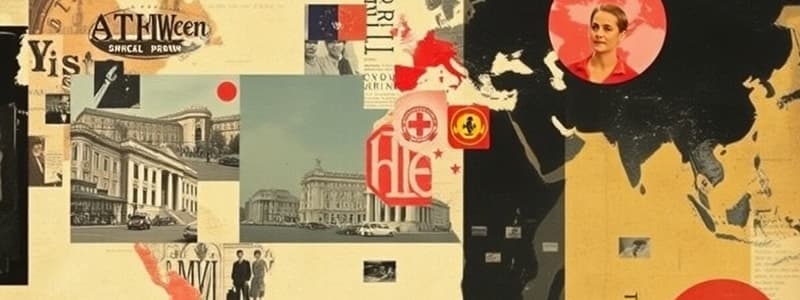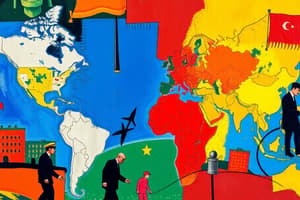Podcast
Questions and Answers
What was one significant consequence of the Second World War on colonial structures in Asia?
What was one significant consequence of the Second World War on colonial structures in Asia?
- Weakening of colonial economic and political structures (correct)
- Creation of new colonies in Asia
- Strengthening of colonial economic structures
- No impact on colonial structures
Which region saw a renewed focus from the British after the loss of colonies in Asia?
Which region saw a renewed focus from the British after the loss of colonies in Asia?
- Africa (correct)
- The Americas
- Australasia
- Oceania
What was a reason for the intensity of conflicts during decolonization?
What was a reason for the intensity of conflicts during decolonization?
- Efforts for gradual decentralization
- Limited resources in colonial territories
- Desire for peaceful coexistence
- The spread of anti-colonial movements (correct)
Which of the following countries experienced decolonization primarily in the late 1940s to early 1960s?
Which of the following countries experienced decolonization primarily in the late 1940s to early 1960s?
What characterized the post-colonial economic conditions in Africa in contrast to Asia?
What characterized the post-colonial economic conditions in Africa in contrast to Asia?
Which ideology influenced many independence movements during decolonization?
Which ideology influenced many independence movements during decolonization?
What was a major outcome of France's colonial wars in Indochina and Algeria?
What was a major outcome of France's colonial wars in Indochina and Algeria?
Which of the following best describes the economic state of many post-colonial countries?
Which of the following best describes the economic state of many post-colonial countries?
What was one of the main problems with the indiscriminate protection of industrial sectors?
What was one of the main problems with the indiscriminate protection of industrial sectors?
How did some states benefit from natural resources after decolonization?
How did some states benefit from natural resources after decolonization?
What impact did humanitarian aid often have on former colonies?
What impact did humanitarian aid often have on former colonies?
What was often the result of high GDP growth rates in post-colonial states?
What was often the result of high GDP growth rates in post-colonial states?
What is a consequence of the creation of powerful lobbies in industrial sectors?
What is a consequence of the creation of powerful lobbies in industrial sectors?
What is a key characteristic of the economic growth observed in some former colonies?
What is a key characteristic of the economic growth observed in some former colonies?
Which countries in the 1930s benefited significantly from emigrant flows in the industrial sector?
Which countries in the 1930s benefited significantly from emigrant flows in the industrial sector?
What was a key factor in the formation of industrial skills in Asian countries?
What was a key factor in the formation of industrial skills in Asian countries?
What can be inferred about the relationship between colonialism and economic dependence?
What can be inferred about the relationship between colonialism and economic dependence?
What typically helped countries succeed in development post-decolonization?
What typically helped countries succeed in development post-decolonization?
What was a common outcome regarding the strength of certain worker classes due to industrial protectionism?
What was a common outcome regarding the strength of certain worker classes due to industrial protectionism?
Which perspective describes the economic impact of departing colonial powers?
Which perspective describes the economic impact of departing colonial powers?
What was an unintended effect of colonial power transfer during decolonization?
What was an unintended effect of colonial power transfer during decolonization?
What characterized the relationship between Western European economies and their colonies during economic integration?
What characterized the relationship between Western European economies and their colonies during economic integration?
What was a consequence of the economic miracles in the West during the 1950s?
What was a consequence of the economic miracles in the West during the 1950s?
Why couldn't former colonies keep pace with their colonial powers after independence?
Why couldn't former colonies keep pace with their colonial powers after independence?
Flashcards
Decolonization in Asia
Decolonization in Asia
The process of former Asian colonies gaining independence from European powers, primarily occurring between 1946 and 1951.
Decolonization in Africa
Decolonization in Africa
The process of former African colonies gaining independence from European powers, primarily occurring between 1956 and 1963.
Weakened Colonial Structures
Weakened Colonial Structures
Asian colonial structures were weakened by World War II, while African ones were relatively strong.
Europe's Post-War Regrouping
Europe's Post-War Regrouping
Signup and view all the flashcards
Second Colonial Occupation
Second Colonial Occupation
Signup and view all the flashcards
Anti-Colonial Movements
Anti-Colonial Movements
Signup and view all the flashcards
Factors of Decolonization
Factors of Decolonization
Signup and view all the flashcards
Violent Decolonization
Violent Decolonization
Signup and view all the flashcards
Industrialization in Latin America (1930s)
Industrialization in Latin America (1930s)
Signup and view all the flashcards
Asian Industrialization (1930s)
Asian Industrialization (1930s)
Signup and view all the flashcards
Post-colonial Development Challenges
Post-colonial Development Challenges
Signup and view all the flashcards
Decolonization's Economic Impacts
Decolonization's Economic Impacts
Signup and view all the flashcards
European Colonial Investment
European Colonial Investment
Signup and view all the flashcards
Unintentional Power Transfer
Unintentional Power Transfer
Signup and view all the flashcards
Western European Economic Integration
Western European Economic Integration
Signup and view all the flashcards
Post-colonial Divergence
Post-colonial Divergence
Signup and view all the flashcards
ISI policy goal
ISI policy goal
Signup and view all the flashcards
ISI policy consequences
ISI policy consequences
Signup and view all the flashcards
ISI policy issues
ISI policy issues
Signup and view all the flashcards
Natural resource abundance
Natural resource abundance
Signup and view all the flashcards
Humanitarian aid effects
Humanitarian aid effects
Signup and view all the flashcards
Post-colonial growth rates
Post-colonial growth rates
Signup and view all the flashcards
Fragile States Index
Fragile States Index
Signup and view all the flashcards
Study Notes
From the West to the "Rest"
- Amatori-Colli, chapter 16, part of chapter 18
- Economic history class 15
- Academic year 2024/2025
- Instructor: Sonia Schifano
In this episode
- Decolonization
- Post-colonial divergence
Distribution of the World's GDP
- 1970: GDP distribution by country area proportional to nominal GDP share
- 1995: GDP distribution by country area proportional to nominal GDP share
- 2020: GDP distribution by country area proportional to nominal GDP share
- Data source: United Nations
Golden Age but...not for everyone
- Western countries grew at an average of 4% during 1950-1973
- Internal disparities existed, for example, between the North and South of Italy
- In 1950-1973:
- Africa's growth rate was approximately 1.8%
- Latin America's growth rate was approximately 2.4%
- Asia's growth rate (excluding Japan) was approximately 2.6%
Golden Age but...not for everyone (continued)
- Is there a common path for development?
- Is underdevelopment a consequence of the success of more advanced countries?
- What is the relationship between rich and poor countries?
- Role of the World Bank and developed economies on less developed countries
- The possibility of competitive advantages for underdevelopment
- Social and ethical costs
Decolonization
- 1945: 51 sovereign countries at the UN, 9 from Asia, and 3 from Africa
- 1960: 120-70 sovereign member states at the UN representing African or Asian countries, showing a shift in power.
- Links between countries and decolonization provided
- The use of a single word "decolonization" to describe the transfer of sovereignty from imperial powers to colonies after 1945 implies a uniform process, but it's not true in reality. Decolonization happened differently across various regions, with varied timelines and causes.
- The British Empire's dissolution in the late 1940s and subsequent struggles by the French and Dutch to maintain their control in areas like Indo-China and the East Indies demonstrate the non-uniformity of the process.
- Colonialism in Africa continued after the Second World War.
Decolonization (continued)
-
Second World War weakened colonial structures in Asia but strengthened them in much of Africa.
-
Britain aimed to regroup their colonial empire around African territories to compensate for the loss of India, Burma, and Ceylon, considered these territories indispensable assets
-
French and Belgian powers regarded their African colonies as vital resources in reconstruction efforts.
-
1946-1951 decolonization happened in Asia. Countries like Philippines, Indonesia, Myanmar, Laos, Vietnam, Cambodia, and Malesia etc. achieved independence
-
1956-1963 decolonization mainly happened in Africa
Decolonization (continued)
- The process of decolonization is often intense.
- France's struggle to maintain control over Indochina, including the 1954 defeat by Vietnam, and the 7-year Algerian War (1962) highlight the conflicts involved in achieving independence.
- Reasons behind decolonization include:
- Anti-colonial movements
- Weakening of European powers after World War II
- Negative stance of the US towards colonial empires
- Rise of communist ideology
The legacies of the past
- Common colonial past created diverse paths for development
- Countries with subsistence agriculture (excluding those that focused on export production) lacked strong manufacturing experience
- Countries that developed significant industrial experience in the 1930s (e.g., Argentina, Brazil, Chile, and Mexico) benefited from European migration and human capital.
- Asian countries relied on flows of skills, influenced by colonial legacy (including European and Japanese input) and American multinational companies.
- Countries that succeeded post-colonization utilized technologies and developed their own development strategies, often with government support.
Decolonization (continued)
- Three perspectives on decolonization:
- "Balance sheets" of European colonial powers focus on private investments leaving colonies prior to loss of political control and resource removal.
- Colonial unintentional power transfer: expatriates leaving gaps in economic activities, leading to the rise of local entrepreneurs.
- Interdependence and integration of Western European economies: colonies became marginalised as European integration progressed.
The post-colonial divergence
- Economic miracles of the 1950s in the West sharply contrasted with the experiences of former colonies.
- Factors hindering the catch-up of former colonies include:
- Dominant primary sector
- High birth rates
- Different stages of the demographic transition
The post-colonial divergence (continued)
- Growing demographic pressure worsened by low per capita income further entrenched poverty in developing countries.
- GDP per capita for Western Europe, Eastern Europe, Latin America, Asia (East), Asia (South and South-East), Middle East, and Sub-Saharan Africa from 1950-2018. Data displayed graphically.
The political instability of former colonies
- Independence didn't erase problems like poverty, illiteracy, and dependence on international trade.
- Fragility in new ruling classes and the role of the military, often leading to dictatorships.
- Bipolar world tensions (USA-USSR conflict) impacted the quest for autonomy in former colonies.
- Bandung Conference (1955) as a significant event promoting solidarity between developing nations.
Recipes for growth
- Developing countries initially pursued autarchic and protectionist policies to industrialize.
- Industrialization was viewed as the most effective path for modernization and economic independence, particularly in Latin America, Asia, and Africa
- However, relying only on this method was insufficient in many instances.
Recipes for growth (continued)
- Import Substitution Industrialization (ISI):
- Developed countries used protectionist high tariff barriers to replace imported goods with domestic production, focusing initially on simple consumer products, then moving towards more technical products.
- The ultimate goal is greater national diversification and less dependence on exports.
The historical experience of ISI
- ISI policy frequently achieved industrialization but did not always translate to increased well-being or per capita income.
- Key problems:
- Strong penalization of the primary sector
- Indiscriminate protection of all industrial sectors, including inefficient ones
- Powerful lobbies preventing necessary industry reforms
- Widespread corruption
- Social conflicts that benefited specific worker classes at the expense of others
Fragile States Index Heat Map, 2022
- Map showing states according to stability levels. Visualization of stability across the world in 2022
The post-colonial divergence (continued)
- Poverty wasn't universal after colonialism. Some nations, particularly those with abundant natural resources (e.g., Gulf economies), saw significant economic growth.
- Humanitarian aid sometimes worsened situations rather than improving them despite extending life expectancy, without significantly increasing income.
The post-colonial divergence (continued)
- Despite challenges, growth after colonialism occurred (though not always universally or evenly distributed)
- Significant growth did take place, yet it wasn't consistent with prosperity.
- In many instances, post-colonial development led to political instability.
Overtaking Japan
- GDP per capita as a percentage of the US in several countries over time (1970 - 2017). Graph.
Studying That Suits You
Use AI to generate personalized quizzes and flashcards to suit your learning preferences.




